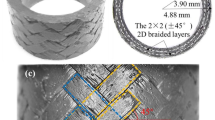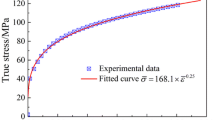Abstract
This paper involves the experimental measurement of residual stresses in a nonwelded nuclear-grade 304 stainless-steel seamless tube subjected to one-sided quenching of its outside surface. Because this grade of tube is used extensively in nuclear power plants, the residual stresses measured are of interest to the nuclear industry. The Sach's boring method was used to obtain residual stresses. The longitudinal and tangential residual stresses at the inner wall were found to be 69 MPa to 138 MPa compressive. The results indicate that the residual-stress distribution would allow the tube to be highly resistant to the formation and propagation of stress-corrosion cracks.
Similar content being viewed by others
References
Lynch, J.J., “The Measurement of Residual Stresses,” Amer. Soc. for Metals, 43–59 (Oct. 1951).
Iwasaki, S., “Methods for Preventing and Ameliorating Cracks in BWR Piping,” Nat. ASsoc. of Corrosion Eng., presented at a conference in 1978 (1982).
Terasaki, M., “Method for Improving the Residual Stress in Austenitic Stainless Steel Pipes and the Like by Induction Heating,” Patent 4354883 (Oct. 9, 1982).
Rybicki, E. andMcGuire, P., “The Effects of Induction Heating Conditions on Controlling Residual Stresses in Welded Pipes,”Eng Tech.,104,267–273 (Oct.1982).
Rybicki, E. and McGuire, P., “A Computational Model for Improving Weld Residual Stresses in Small-Diameter Pipes by Induction heating,” ASME Paper No. 80-C2/PVP-152 (1980).
Arii, M. and Miki, M., “Induction Heating Stress Improvement Method for Austenitic Stainless Steel Piping in BWR's,” J. Atomic Energy Soc. of Japan, 292–300 (April 1984).
Beckwith, Buck and Marangoni, Mechanical Measurements, Addison-Wesly Publishing Co., 3rd Ed., 374–380 (1982).
Gerald, C., Applied Numerical Analysis, Addison-Wesley Publishing Company, 2nd Ed., 468–474 and 505–507 (May 1980).
Sachs, G., “Den Nachweis Innerer Spannungen In Stangen und Rohren,” Zeitschrift Fur Metallkunde, 19th Annual, (9), 352–357 (Sept. 1927).
Mahlmann, C. V. andMurray, W. M., “Proceedings of the Society for Experimental Stress Analysis,”SESA,10 (1),108–112 (1952).
Juvinall, R., Stress, Strain and Strength, McGraw-Hill Book Co., 558–565 (1967).
Mendelson, A., Plasticity: Theory and Application, Robert E. Krieger Publishing Co., 102–103 (1968).
Schroder, R., “Some Influences on the Development of Thermal and Residual Stresses in Quenched Steel Cylinders with Diffeent Dimensions,” Proc. Int. Symp. on the Calculation of Internal Streses in Heat Treatment of Metallic Materials, Linkoping, Sweden, 1–13 (May 1984).
Author information
Authors and Affiliations
Rights and permissions
About this article
Cite this article
Kovac, M., Miyano, Y. & Woo, T.C. Residual-stress measurement in SS304 seamless tube. Experimental Mechanics 29, 209–213 (1989). https://doi.org/10.1007/BF02321377
Received:
Revised:
Issue Date:
DOI: https://doi.org/10.1007/BF02321377




